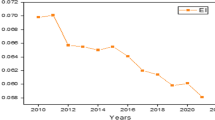Abstract
This paper analyzes the drivers for and barriers to the adoption of energy efficient technologies among a sample of firms based in Viet Nam, the Philippines, and Moldova. The current debate on the fight against climate change emphasizes the need to adopt environmentally friendly measures at the global level. We therefore need to better understand the obstacles to the adoption of energy saving measures, especially in developing countries. By applying discrete choice modeling techniques, we find that firms’ internal management and organizational factors rather than top-down or other external market conditions increase firms’ likelihood to invest in energy efficient technologies. Moreover, experience in the adoption of energy efficient technologies and the commitment of top management are also crucial in this regard.
Similar content being viewed by others
Notes
We use 116 observations from the entire sample of 214 due to missing data.
References
Alcorta, L., Brazilian, M., De Simone, G., & Pedersen, A. (2014). Return on investment from industrial energy efficiency: evidence from developing countries. Energy Efficiency, 7, 43–53.
Apeaning, R., & Thollander, P. (2013). Barriers to and driving forces for industrial energy efficiency improvements in African industries—a case study of largest industrial area. Journal of Cleaner Production, 53, 204–213.
Bhattacharya S., Cropper M. (2010), “Options for energy efficiency in India and barriers to their adoption”, Resource for the Future, DP 10–20.
Borghesi, S., Cainelli, G., & Mazzanti, M. (2015). Linking emission trading to environmental innovation : evidence from the Italian manufacturing industry. Research Policy, 44, 669–683.
Bosetti, V., Carraro, C., & Galeotti, M. (2006). The dynamics of carbon and energy intensity in a model of endogenous technical change. The Energy Journal, Special Issue, 1, 191–206.
Brunke, J., Johansson, M., & Thollander, P. (2014). Empirical investigation of barriers and drivers to the adoption of energy conservation measures, energy management practices and energy services in the Swedish iron and steel industry. Journal of Cleaner Production, 84, 509–525.
Cagno, E., & Trianni, A. (2013). Exploring drivers for energy efficiency within small—and medium sized enterprises: first evidence from Italian manufacturing enterprises. Applied Energy, 104, 276–285.
Cantore N., Calì Massimiliano., & te Velde D. (2016), “Does energy efficiency improve technological change and economic growth in developing countries?”, Energy Policy, 92, 279–285.
De Groot, H., Verhoef, E., & Nijkamp, P. (2001). Energy savings by firms: decision making, barriers and policies. Energy Economics, 23, 717–740.
del Rio, P. (2005). Analysing the factors influencing clean technology adoption: a study of the Spanish pulp and paper industry. Business Strategy and the Environment, 14(1), 20–37.
del Rio, P., Romero-Jordán, D., & Peñasco, C. (2015). Analyzing firm-specific and type-specific determinants of eco-innovation. Technology and Economic Development of Economy. doi:10.3846/20294913.2015.1072749.
del Rio, P., Peñasco, C., & Romero-Jordán, D. (2016). What drives eco-innovators? A critical review of the empirical literature based on econometric methods. Journal of Cleaner Production, 112, 2158–2170.
Fadden, D. (1976). Quantal choice analysis: a survey. Annals of economics and social measurement, 5(4), 363–390.
Farell, D., & Remes, J. (2009). Promoting energy efficiency in the developing world. McKinsey & Company.
Fleiter, T., Schleich, J., & Ravivanpong, P. (2012). Adoption of energy efficiency measures in SMEs—an empirical analysis based on energy audit data from Germany. Energy Policy, 51, 63–875.
Gillingham K., Newell R., Palmer K. (2009), “Energy efficiency economics and policy”, Resource for the Future working Paper, 09–13.
Johansson M. (2015), “Improved energy efficiency within the Swedish steel industry— the importance of energy management and networking”, Energy Efficiency, 8, 713–744.
Luken, R., Van Rompaey, F., & Zigová, K. (2008). The determinants of EST adoption by manufacturing palnts in developing countries. Ecological Economics, 66, 141–152.
Luong, N. (2015). A critical review on energy efficiency and conservation policies and programs in Viet Nam. Renewable and Sustainable Energy Reviews, 52, 623–634.
Merlevede, B., Verbeke, T., & De Clercq, M. (2006). The EKC for SO2: does firm size matter? Ecological Economics, 59, 451–461.
Schleich, J. (2009). Barriers to energy efficiency: a comparison across the German commercial and services sector. Ecological Economics, 68, 2150–2159.
Schleich, J., & Gruber, E. (2008). Beyond case studies: barriers to energy efficiency in commerce and the services sector. Energy Economics, 30, 449–464.
Thollander, P., & Ottosson, M. (2008). An energy efficient pulp and paper industry – exploring barriers to and driving forces for cost—effective energy efficiency investments. Energy Efficiency, 1, 21–34.
Train, K., & Winston, C. (2007). Vehicle choice behaviour and the declining market share of us automakers. International Economic Review, 48, 1469–1496.
Trianni, A., & Cagno, E. (2012). Dealing with barriers to energy efficiency and SMEs: some empirical evidences. Energy, 37, 494–504.
Trianni A., Cagno E., Worrell E., Pugliese G. (2013), “Empirical investigation of energy efficiency barriers in Italian manufacturing small and medium enterprises”, Energy, 49, 444–458.
UNIDO 2011, “Industrial energy efficiency for sustainable wealth creation: capturing environmental, economic and social dividends”. Vienna.
Worrell, E., Laitner, J., Ruth, M., & Finman, H. (2003). Productivity benefits of industrial energy efficiency measures. Energy, 28, 1081–1098.
Acknowledgments
This research expands on background work carried out for the UNIDO Industrial Development Reports 2011 and 2016. The author is very grateful to Niki Rodousakis, UNIDO, for assistance.
Author information
Authors and Affiliations
Corresponding author
Rights and permissions
About this article
Cite this article
Cantore, N. Factors affecting the adoption of energy efficiency in the manufacturing sector of developing countries. Energy Efficiency 10, 743–752 (2017). https://doi.org/10.1007/s12053-016-9474-3
Received:
Accepted:
Published:
Issue Date:
DOI: https://doi.org/10.1007/s12053-016-9474-3




